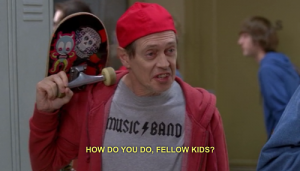My Take on Why Humour Is Totally Easy and Not Even Risky: Natalie Jones Tells Us How to Connect with the Fellow Kids
Natalie Jones of WooRank
Inbound Comedy: Stand out by making your audience laugh
I won’t try to be humorous in this blog post, as I’ll only be setting myself up for criticism along the lines of: ‘Did you even understand the talk?’. Yes, I maybe did, but I’m squirrelling away all of my new-found golden witticisms for my client’s social strategies, of course! Aside from that, though, ‘how to be funny’ wasn’t the only thing to take from this talk. Ultimately, what I took from this talk was not just how to be endlessly humorous, but also what humour can help you achieve. So, even for the humour-deficient of us out there, we can still take away the end goals of a light, maybe even witty, social post. That goal, of course, is connection.Humour often revolves around the idea that the deliverer of the joke understands the tastes of the recipient. So many comedians base their entire sets around this concept: ‘It’s funny because it’s true’. They humorously relay a real life, tangible experience. It is within this that the power of humour lays – if you make your audience chuckle, you will also make them feel understood and therefore strengthen the connection that they feel towards you. They find the ‘bit’ relatable, therefore you have related to them. Plus it makes you seem funny, and funny is cool.


- Identity
By establishing, and fully comprehending, your brand’s identity, you can hone and target your humour accordingly. By returning to your identity as the source for your creativity, you are helping yourself by giving yourself a springboard for your ideas. Is your brand all about providing manly fragrance? Make your humour revolve around being a man. Like, a ‘real’ man. Thank you, Old Spice [https://youtu.be/owGykVbfgUE]. By establishing and then basing your humour on your brand’s identity or USP (Unique Selling Point), your message never goes off-track, you’re strengthening your brand in the eyes of your audience, and you are making them laugh and therefore feel understood, all in one. - Feelings
People want to feel things. Preferably, good things. ‘Good’ covers a wide spectrum, from ‘inspired’ to ‘mildly amused’. We’ll look at amused. 58% of millennials go on social media just to be entertained. If you manage to make them pause for even a moment and give that slightly accelerated out-breath through their nose that is the modern day equivalent of wildly uproarious laughter, then you have prompted a positive feeling within them, leaving them entertained by your brand. Here’s the thing, if someone is going onto social media looking to be entertained, then they are more likely to be entertained. They are open to the potential of snorting slightly. Therefore, you don’t actually need to give them much to achieve this desired nose-snort reaction. Therefore, identify the feeling you want to portray alongside humour. Are you aloof and sarcastic, in order to inspire the feeling of ‘superiority’ over other brands, or are you warm and fuzzy with cat memes so that your audience feels cuddly about your brand? This goes back to ‘identity’, as it will sharpen your focus once more. - Focus
Who is watching you? Don’t check over your shoulder. Check, instead, your engagement. We allknow that, in this industry, there is a certain amount of trial-and-error, but that’s often forgotten with social media. You have actually got a wonderful trial-and-error tool in these platforms, though. Due to how quickly this all moves, anything that fails will quickly be at the very bottom of everyone’s feed and you can learn from it quickly and try something different. By doing this enough times, and really taking note of what gets a reaction, you can start to understand your audience and therefore sharpen your focus. It teaches you who is paying attention to you, and what they want to see. This leads nicely into the next point… - Freedom
You have so much freedom on social media. What I was saying before, about trying all the different things to see what works, you have to give yourself the freedom to do that. As social media marketers, we have permission to fail, because that is the only way we will learn what works. We have to take risks, otherwise, we will never make a big impact, and taking risks means failing big sometimes. But, it can also mean succeeding big, too. Here’s the trick though – if you’ve established your brand identity, decided on the feelings you want to convey, and focus in on who your audience are and what they want, the ‘risky’ choices stop really being a risk at all. You’ve built yourself a nice little brand strategy pen to play in, with padding, so you can bounce your creativity off the walls all you like with only the tiniest risk of concussion.
I’ve also written a blog post, the final one in this series, on the Brighton SEO keynote speaker. If you think I’ve missed an amazing talk that should have been covered here, let us know, and I’ll probably explain why it might have just been too far over my head to explain like you’re all 11. If you didn’t understand that reference, read the first and second parts of this series here and here.The slides from Natalie’s talk are available to view here and there’s even a video. Make sure to check out more of Natalie’s company, WooRank, on their Facebook and Twitter (@woorank) where I’m sure they’ll be retweeting this blog post any… moment… now.
